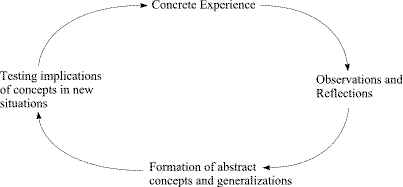
Theories of Learning
by Joe Sinclair

There are a lot of different theories of how people learn and I am not only unable to describe all of them in the confines of this magazine article, but I would be the wrong person to try and explain them in any great depth.
I take heart however from the Shavian dictum about those who can and those who teach, and would like to whet your appetite by introducing you to just a few of these theories and providing links to further study.
All teachers have their own particular styles of teaching, and their own particular beliefs about the best way of learning. It can be very revealing and instructive to study how successful teachers, specifically those who favour other methods than your own, achieve their results. Neuro-Linguistic Programming, for instance, was developed as a result of two University of California colleagues exploring just such a modelling of excellence by Fritz Perls (Gestalt), Virginia Satir (Family Therapy) and Milton Erickson (Hypnotherapy).
Here is a list of the (few) theories I have included in this article. Positive feedback may encourage me to add to the list in a future issue of Nurturing Potential. In the meantime, you can go directly to any of the theories by clicking on the title:
ACTION LEARNING
Action Learning is the approach that links the world of learning with the world of action through "action learning sets". These "sets" are small groups that meet regularly to study the real-life issues of their members, seeking to learn with and from each other. The founder of Action Learning, Reg Revans, maintained that there can be no learning without action and no specific action without learning. He was scathing about the value of traditional ‘chalk and talk’ management education which prevailed during the 1960s and 1970s, arguing that people learned most effectively not from books, lecturers or teachers, but from sharing real problems with others.
He argued that Action Learning is ideal for solving problems that do not have a "right" answer because people learning from and with each other in "sets" are able to achieve the appropriate questioning insight.
Some of the big advantages in working within these sets are:
Sharing the work load.
Covering a wider research base.
Increased and varied thinking power.
Greater self-awareness and self-confidence due to new insights and feedback.
Enhanced working relationships with team members.
Ability to ask better questions and be more reflective.
Learning from the varied strengths of others within the sets.
ANDRAGOGY (ADULT LEARNING)
The term Andragogy was invented by the German Alexander Kapp in 1833 to differentiate adult learning from Pedagogy (learning by children). The concept of Adult Learning was further developed by Malcolm Knowles (The Adult Learner, 1978) who believed that adulthood was the province of people who believe themselves to be adults and who behave in adult ways. Such people should be treated as adults. In Knowles's own words, "Andragogy is the art and science of helping adults learn".
It is my own observation that those students who have entered a professional school or a job have made a big step toward seeing themselves as essentially self-directing. They have largely resolved their identity-formation issues; they are identified with an adult role. Any experience that they perceive as putting them in the position of being treated as children is bound to interface with their learning. (Knowles, 1978:56)
Andragogy assumes that the point at which an individual achieves a self-concept of essential self-direction is the point at which the individual psychologically becomes adult. A very critical thing happens when this occurs: individuals develop a deep psychological need to be perceived by others as being self-directing. Thus, when in a situation in which they are not allowed to be self-directing, they experiences a tension between that situation and their self-concept. Their reaction is bound to be tainted with resentment and resistance.
Knowles makes the following assumptions: (Knowles 1990)
The need to know. Adult learners need to know why they need to learn something before attempting to learn it.
Learner self-concept. Adults need to be responsible for their own decisions and to be treated as capable of self-direction.
Role of learners' experience. Adult learners have a variety of experiences of life which represent the richest resource for learning. These experiences are, however, imbued with bias and presupposition.
Readiness to learn. Adults are ready to learn those things they need to know in order to cope effectively with life situations.
Orientation to learning. Adults are motivated to learn to the extent that they perceive that it will help them perform tasks they confront in their life situations.
One major criticism of Knowles' andragogy is that its emphasis on learning from peers makes it an inefficient instrument for the transmission of knowledge, although they value the way in which it avoids (or evades) the problems of resentment of authority and counter-dependence which they see as implicit in the normal pedagogic structure.
COGNITIVE LEARNING THEORY
This is a general approach that views learning as an active mental process of acquiring, remembering, and using knowledge. Learning is evidenced by a change in knowledge which makes a change in behaviour possible. Learning itself is not directly observable.
Basic to the theory is the belief that learning proceeds through a series of stages. It begins with the cognitive stage, an instructional stage where the learner develops a rough mental representation of task requirements. In the second stage, the associative stage, this representation is strengthened and refined, but remains subject to rules and is not yet divorced from outside support. The third stage of learning is the autonomous stage where the learner is able to perform the task automatically and autonomously. Fundamental to cognitive learning theory is the necessity for students to progress through these stages, with extensive practice and feedback, as well as instruction in the use of various learning strategies.
Cognitive learning theory owes much to the work of Benjamin Bloom (1956) whose theories were widely applied in law enforcement training. Bloom identified six levels of learning, ranging from simple recognition or recall of facts at its base, through increasingly complex and abstract mental levels, to the highest order - evaluation. These were:
Knowledge: arrange, define, duplicate, label, list, memorise, name, order, recognise, relate, recall, repeat.
Comprehension: classify, describe, discuss, explain, express, identify, indicate, locate, recognise, report, restate, review, select, translate.
Application: apply, choose, demonstrate, dramatise, employ, illustrate, interpret, operate, practice, schedule, sketch, solve, use, write.
Analysis: analyse, appraise, calculate, categorise, compare, contrast, criticise, differentiate, discriminate, distinguish, examine, experiment, question, test.
Synthesis: arrange, assemble, collect, compose, construct, create, design, develop, formulate, manage, organize, plan, prepare, propose, set up, write.
Evaluation: appraise, argue, assess, attach, choose, compare, defend, estimate, judge, predict, rate, core, select, support, value, evaluate.
EXPERIENTIAL LEARNING
"Tell me and I will forget. Show me and I may remember. Involve me and I will understand." Such was the advice of Confucius about half a millennium before the birth of Christ.
Some two-and-a-half millennia later, David Kolb's Experiential Learning: experience as the source of learning and development (1984) preached a similar message and had an enormous influence on the process of designing and developing a learning model for a lifetime.
The kick-off point for Kolb's model is Kurt Lewin's cycle of adult learning:

Kolb posited that people learn in four ways, with one mode of learning being more developed than another (see above) and that it did not really matter at which point in the cycle individuals began.
Subsequently, Honey and Mumford, building on Kolb's work, identified four learning styles: Activist (enjoying the experience itself), Reflector (spending much time and effort in reflection), Theorist (good at making connections and abstracting ideas from experience), and Pragmatist (enjoying the planning stage). Here is the model expressed graphically:
There are strengths and weaknesses in each of these styles. Honey and Mumford argue that learning is enhanced when we think about our learning style so that we can build on strengths and work towards minimising weaknesses to improve the quality of learning.
HUMANIST LEARNING THEORY
This emphasises the natural desire of everyone to learn and maintains that learners need to be empowered to have control over the learning process. From the follows the requirement that the teacher relinquishes a great deal of authority and becomes a facilitator. Hence the theory is sometimes called the Facilitative Learning Theory.
This model is particularly associated with Carl Rogers and Abraham Maslow from the field of psychology, John Holt from the province of child education, and Knowles and Kolb, whom we have already encountered in connection with the theories of Andragogy and Cognitive Learning respectively.
The main characteristic of the theory is, as stated above, that educators act as facilitators in order to produce a more comfortable atmosphere in which learners do not feel threatened by external factors. But other premises are that while people have a natural desire to learn, there is a fundamental resistance to abandoning currently held beliefs, and that the most significant aspect of learning consists of changing one's concept of oneself.
In the humanist model, teachers are less protective of their own beliefs and more willing to pay attention to learners and to respect their feelings. They also tend to pay as much attention to their relationship with the learners as they do to the content of the material being taught. Furthermore all feedback is regarded as positive and is welcomed as an insight into themselves and their own behaviour.
Learners are encouraged to take responsibility for their own learning and to contribute their insights and experiences to the common benefit. The most valuable evaluation is considered to be self-evaluation and learning is encouraged to focus on factors that help solve significant problems or achieve significant results.
REINFORCEMENT LEARNING
This is a learning theory that was developed by the behaviourist school of psychology, notably by B.F. Skinner, early in the 20th century, the basic concept being that a learner will repeat a desired behaviour if positive reinforcement, i.e. a pleasant consequence, follows the behaviour.
Positive reinforcement, or rewards, can range from verbal reinforcement such as "Well done", or "You've picked that up pretty well", to more tangible rewards, such as a prized qualification at the conclusion of a course, or promotion to a higher position within an organisation.
Negative reinforcement may also strengthen a behaviour when a negative situation may be avoided or stopped as a result of the behaviour.
There are actually three rules governing reinforcement:
1. Consequences which give rewards increase a behaviour.
2. Consequences which give punishments decrease a behaviour.
3. Consequences which give neither rewards nor punishments extinguish a behaviour.
Reinforcement, in other words, is another name for the outcomes of our behaviour. Its value refers to the desirability of these outcomes. Things we want to happen, that we are attracted to, have a high reinforcement value. Things we don't want to happen, that we wish to avoid, have a low reinforcement value. If the likelihood of achieving reinforcement is the same, we will exhibit the behaviour with the greatest reinforcement value, i.e. the one directed toward the outcome we most desire.
An article published on the Internet by the University of Houston in 1995 (Behaviourism as a Learning Theory) suggested the following five stages to a behaviour change programme:
1. Set behaviour goals
2. Determine appropriate reinforcers
3. Select procedures for changing behaviour
4. Implement procedures and record results
5. Evaluate progress and revise as needed.
It may be of interest to note that Reinforcement Learning is currently an actively researched topic in artificial intelligence (AI).
![]()
Joe Sinclair is a writer, editor, publisher, and non-executive director of a shipping line - amongst other activities - one of which is the publishing of Nurturing Potential. His personal website will be found at http://www.conts.com.